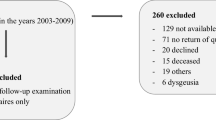Abstract
The aim of this study was to evaluate the effect of olfactory dysfunction on quality of life (QOL), and to investigate olfactory dysfunction related self-reported clinical features in Turkish population. The participants were questioned about the presence of any olfactory dysfunction. Participants with a complaint of olfactory dysfunction were asked to fill out a survey and then a validated olfactory test was performed. We asked 2,824 volunteers whether they had olfactory dysfunctions or not. A total of 199 (6.7 %) people mentioned that they had, and filled out the questions in our survey. The mean age of the surveyed population was 44 ± 15 years. The current investigation produced four major findings (1) the feeling of inadequacy due to olfactory dysfunction was more common among females than males (2) there was a significant correlation between subjective olfactory complaints and objective olfactory testing (3) problems in QOL issues are typically reported primarily in the areas of safety and nutrition (4) the possible reasons for the olfactory dysfunction according to the volunteers were upper respiratory infections including rhinosinusitis (46 %), allergic rhinitis (27 %), severe face and head trauma (6.5 %). The effect of subjective olfactory dysfunctions on QOL among the Turkish population was investigated for the first time. Problems in daily life issues are typically reported primarily in the areas of safety and nutrition.
Similar content being viewed by others
References
Jacob S, McClintock MK, Zelano B, Ober C (2002) Paternally inherited HLA alleles are associated with women’s choice of male odor. Nat Genet 30:175–179
Baron RA (1997) The sweet smell of helping: effects of pleasant ambient fragrance on prosocial behaviour shopping malls. Personal Soc Psychol Bull 23:489–503
Vernet-Maury E, Alaoui-Ismaili O, Dittmar A et al (1999) Basic emotions induced by odorants: a new approach based on autonomic pattern results. J Auton Nerv Syst 75:176–183
Frasnelli J, Hummel T (2005) Olfactory dysfunction and daily life. Eur Arch Otorhinolaryngol 262(3):231–235
Olsson P, Berglind N, Bellander T, Stjärne P (2003) Prevalence of self-reported allergic and non-allergic rhinitis symptoms in Stockholm: relation to age, gender, olfactory sense, and smoking. Acta Otolaryngol 123:75–80
Murphy C, Schubert CR, Cruickshanks KJ, Klein BE, Klein R, Nondahl DM (2002) Prevalence of olfactory impairment in older adults. JAMA 288:2307–2312
Landis BN, Hummel T (2006) New evidence for high occurrence of olfactory dysfunctions within the population. Am J Med 119(1):91–92
Nordin S, Brämerson A, Millqvist E, Bende M (2007) Prevalence of parosmia: the Skövde population-based studies. Rhinology 45(1):50–53
Nordin S, Bramerson A, Bende M (2004) Prevalence of self-reported poor odor detection sensitivity: the Skovde population-based study. Acta Otolaryngol 124:1171–1173
Nordin S, Brämerson A (2008) Complaints of olfactory disorders: epidemiology, assessment and clinical implications. Curr Opin Allergy Clin Immunol 8(1):10–15
Simopoulos E, Katotomichelakis M, Gouveris H, Tripsianis G, Livaditis M, Danielides V (2012) Olfaction-associated quality of life in chronic rhinosinusitis: adaptation and validation of an olfaction-specific questionnaire. Laryngoscope 122(7):1450–1454
Rosen CA, Lee AS, Osborne J, Zullo T, Murry T (2004) Development and validation of the voice handicap index-10. Laryngoscope 114(9):1549–1556
Hummel T, Kobal G, Gudziol H et al (2007) Normative data for the ‘‘Sniffin’ Sticks’’ including tests of odor identification, odor discrimination, and olfactory thresholds: an upgrade based on a group of more than 3,000 subjects. Eur Arch Otorhinolaryngol 264(3):237–243
Tekeli H, Altundağ A, Salihoğlu M, Cayönü M, Kendirli MT (2013) The applicability of the “Sniffin’ Sticks” olfactory test in a Turkish population. Med Sci Monit 30(19):1221–1226
Hummel T, Sekinger B, Wolf S, Pauli E, Kobal G (1997) “Sniffin’ Sticks”: olfactory performance assessed by the combined testing of odor identification, odor discrimination and olfactory threshold. Chem Senses 22(1):39–52
Kobal G, Klimek L, Wolfensberger M et al (2000) Multicenter investigation of 1,036 subjects using a standardized method for the assessment of olfactory function combining tests of odor identification, odor discrimination, and olfactory thresholds. Eur Arch Otorhinolaryngol 257(4):205–211
Hummel T, Heilmann S, Murphy C (2002) Age-related changes of chemosensory functions. In: Rouby C, Schaal B, Dubois D, Gervais R, Holley A (eds) Olfaction, taste and cognition. Cambridge University Press, New York, pp 441–456
Murphy C, Nunez K, Whithee J, Jalowayski AA (1985) The effects of age, nasal airway resistance and nasal cytology on olfactory threshold for butanol. Chem Senses 10:418
Paik SI, Lehman MN, Seiden AM, Duncan HJ, Smith DV (1992) Human olfactory biopsy: the influence of age and receptor distribution. Arch Otolaryngol 118:731–738
Hummel T, Barz S, Pauli E, Kobal G (1998) Chemosensory event-related potentials change with age. Electroencephalogr Clin Neurophysiol 108:208–217
Acknowledgments
The authors acknowledge the help of Dr Thomas Hummel in the preparation of this article.
Disclosures
The authors state that they have no funding, financial relationships, or conflicts of interest.
Author information
Authors and Affiliations
Corresponding author
Rights and permissions
About this article
Cite this article
Altundag, A., Tekeli, H., Salihoglu, M. et al. A Study on Olfactory Dysfunction in Turkish Population with using Survey Method and Validated Olfactory Testing. Indian J Otolaryngol Head Neck Surg 67, 7–12 (2015). https://doi.org/10.1007/s12070-014-0720-8
Received:
Accepted:
Published:
Issue Date:
DOI: https://doi.org/10.1007/s12070-014-0720-8




